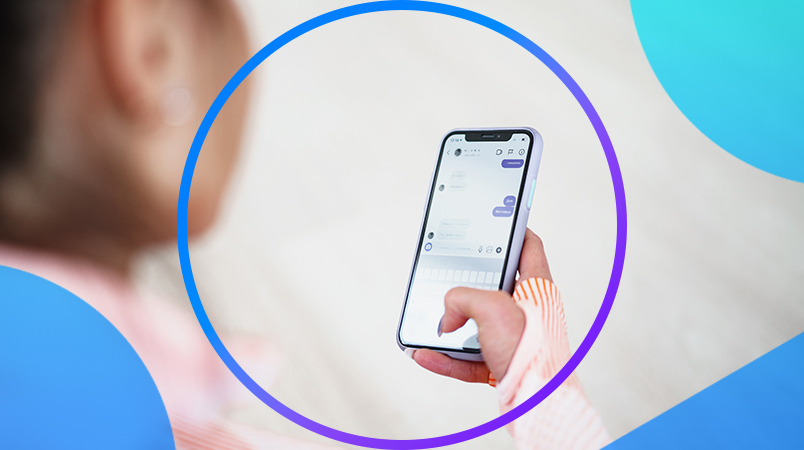What is customer self-service?
Self-service enables customers to find the information they need without having to wait in a queue for customer service agents, or even having to speak to a human at all. It involves automating (and simplifying) elements of the customer service journey to relieve reliance on your CS team to answer repetitive questions. And it’s becoming a popular option for consumers; a Microsoft survey of global customers found that 88% of consumers expect brands to operate a self-service portal.
Making customer service as seamless as possible sometimes involves removing the human element. In some instances, it’s more practical, more efficient, and more cost effective to create an environment where customers can do some of the heavy lifting themselves. Our own chatbot research found that 98% of customer service agents believed chatbots helped to improve the customer service experience.
The benefits of self-service for the customer
Reduce wait times
Customer service teams often have to deal with repetitive customer queries. These types of calls can stack up quickly meaning that those customers with more complex, nuanced issues have to wait longer. That leads to frustration and can cause more pain for both customers and, ultimately, your customer service agents.
24/7 support
With a comprehensive self-service solution in place, your customers can find the information they need at any time, not just between your customer service team’s working hours. If you’re already running a team around the clock to handle customer queries, a self-service offering can be game-changing for your business.
Improve customer experience
Ultimately, it’s all about customer experience. If you’ve had a good or great experience with a brand, there’s a good chance they’ll want to buy from you again. If they have a bad or frustrating experience, Microsoft’s survey suggests 61% may not come back.
The benefits of self-service for businesses
Reduce live contact
Being able to focus on challenging, time-consuming issues instead of repetitive, informational requests is not only a more effective use of your agents’ time, it’s also more rewarding for them.
Reduce stress and boost productivity
Giving your customer service agents time to breathe will help to reduce stress within the team. In our own chatbot research, 84% of customer service agents surveyed said they thought that effective chatbots could help reduce workplace stress.
Reduce costs and excellent ROI
Outsourcing out-of-hours customer care to work forces in other territories is fairly standard practice but you can create efficiencies by automating key elements of your customer service offering. Allowing customers to self-serve reduces (or removes) your reliance on additional staffing, reducing costs.
How do I make my business self-service-ready?
The recent ‘dash to digital’ by global brands, partly as a reaction to the COVID-19 pandemic, has led to a huge uptick in chatbot usage. A new study by Juniper Research predicts that Chatbot interactions will exceed 10 billion by 2027; a mark of their impact on customer conversations and their ability to assist in self-service.
So let’s take a look at the chatbot options on offer:
Chatbots
Chatbots come in the form of scripted or AI chatbots and are, by nature, brilliant at certain aspects of customer service, especially when it comes to delivering answers to simple, informational questions. That’s not all they’re capable of, however, as scripted chatbots can deliver complex responses to difficult questions provided they are programmed with the right ‘script’.
AI chatbots, on the other hand, are able to learn from interactions and can use that learning to actively seek out information to answer customer queries. That makes them particularly adept at dealing with more complex queries.
Whether you choose a scripted or AI chatbot, however, they can both be configured to escalate interactions to a human agent when certain parameters are met.
Voicebots
Voicebots offer a familiar experience to those who prefer to chat through their issues with a human, but one that doesn't tie up your customer service agents. Instead, voicebots can be used to answer informational and data-update requests and direct pre-screened callers through to a real person should that be required.
Self-service in action
If you want to see how self-service affects business in the real world, here’s how the brands we work with deliver self-service opportunities to their customers.
Missguided
Fashion brand MIssguided enjoyed rapid customer growth but with that came new customer service challenges. The solution: a chatbot. During the first few weeks engagement with the chatbot on Missguided’s help page reached 65%. Eleven months later, it was at 80%. This high level of engagement had the twin benefits of reducing both contacts and costs by 14%
Missguided found that investing in tools such as Google Analytics to complement the chatbot allowed them to create a data-driven decision-making strategy and helped them to track ROI accurately.
VIVID
VIVID wanted to give their customers more contact options and also address the issue of knowledge retention and new staff training. Using our Conversational AI Cloud solution, VIVID was able to deploy a chatbot and voicebot solution that, combined, offered a 24/7 customer service solution that revolutionised customer experience.
NI Water
With a vast customer base, NI Water wanted to ensure its customers could get answers fast. Its chatbot integration allowed it to offer a new route for customers to interact with the business. From day one, the chatbot was able to answer 70% of customer enquiries, while two years later that figure had increased to 93%, with the chatbot handling 2500-3000 customer interactions per month.
Find out more about how you can build a self-service environment for your brand with our Conversational AI Cloud, or get in touch to discuss your needs with a member of our specialist team.









